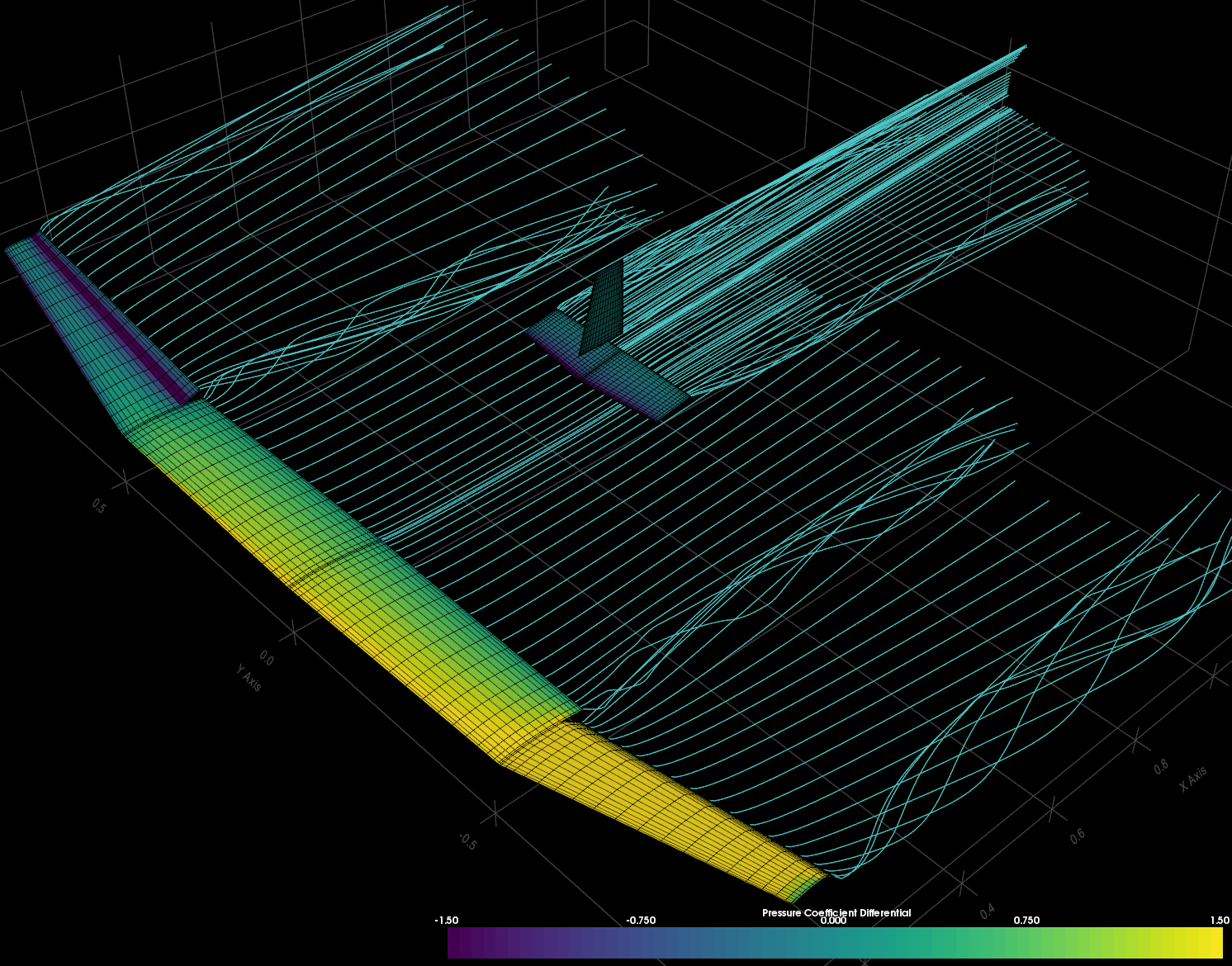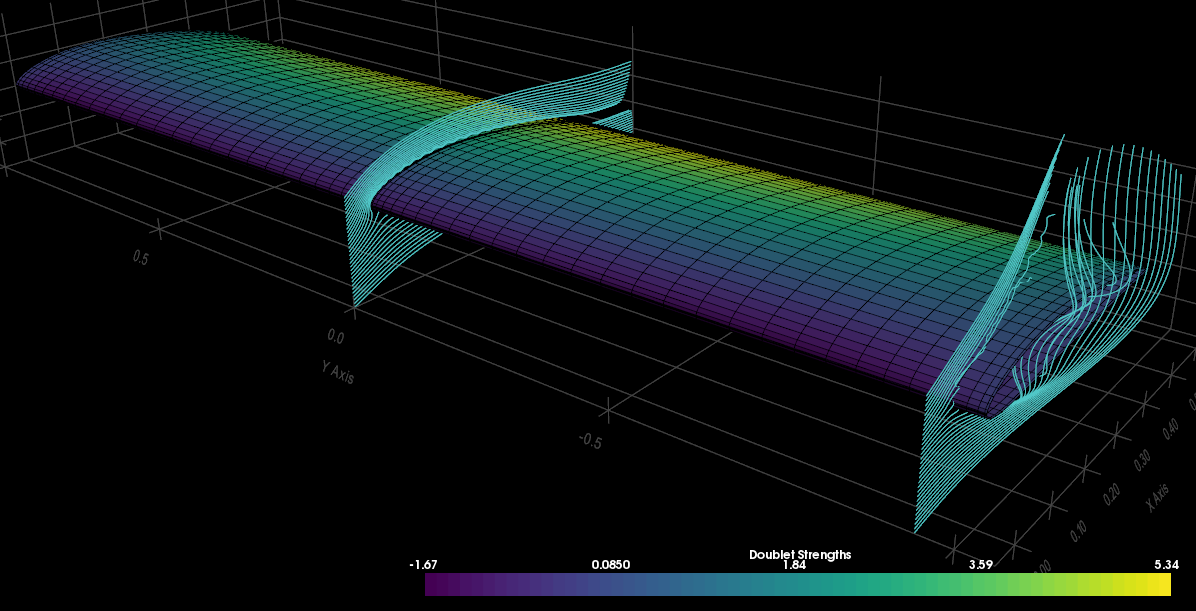peterdsharpe / Aerosandbox
Programming Languages
Projects that are alternatives of or similar to Aerosandbox
AeroSandbox ✈️
by Peter Sharpe (<pds [at] mit [dot] edu>)
Overview
AeroSandbox (ASB) is a Python package for aircraft design optimization that leverages modern tools for reverse-mode automatic differentiation and large-scale design optimization.
At its heart, ASB is a collection of end-to-end automatic-differentiable models and analysis tools for aircraft design applications. This property of automatic-differentiability dramatically improves performance on large problems; design problems with thousands or tens of thousands of decision variables solve in seconds on a laptop. Using AeroSandbox, you can simultaneously optimize an aircraft's aerodynamics, structures, propulsion, mission trajectory, stability, and more.
AeroSandbox has powerful aerodynamics solvers (VLM, 3D panel) written from the ground up, and AeroSandbox can also be used as a standalone aerodynamics solver if desired. Like all other modules, these solvers are end-to-end automatic-differentiable. Therefore, in half a second, you can calculate not only the aerodynamic performance of an airplane, but also the sensitivity of aerodynamic performance with respect to an arbitary number of design variables.
 VLM3 simulation of a glider, aileron deflections of +-30°. Runtime of 0.35 sec on a typical laptop (i7-8750H).
VLM3 simulation of a glider, aileron deflections of +-30°. Runtime of 0.35 sec on a typical laptop (i7-8750H).
 PANEL1 simulation of a wing (extruded NACA2412, α=15°, AR=4). Note the strong three-dimensionality of the flow near the tip.
PANEL1 simulation of a wing (extruded NACA2412, α=15°, AR=4). Note the strong three-dimensionality of the flow near the tip.
Getting Started
Installation and Tutorials
Install with pip install AeroSandbox. Requires Python 3.7+.
Alternatively, clone from master on GitHub and install with pip install ..
To get started, check out the tutorials folder here!
Usage
AeroSandbox is designed to have extremely intuitive, high-level, and human-readable code. You (yes, you!) can probably learn to analyze a simple airplane and visualize airflow around it within 5 minutes of downloading AeroSandbox. For example, here is all the code that is needed to design a glider, analyze its aerodynamics in flight, and visualize it (found in /examples/conventional/casll1_conventional_analysis_point.py):
from aerosandbox import *
glider = Airplane(
name="Peter's Glider",
xyz_ref=[0, 0, 0], # CG location
wings=[
Wing(
name="Main Wing",
xyz_le=[0, 0, 0], # Coordinates of the wing's leading edge
symmetric=True, # Should we mirror the wing across the XZ plane?
xsecs=[ # The wing's cross ("X") sections
WingXSec( # Root cross ("X") section
xyz_le=[0, 0, 0], # Coordinates of the XSec's leading edge, relative to the wing's leading edge.
chord=0.18,
twist_angle=2, # degrees
airfoil=Airfoil(name="naca4412"),
control_surface_type='symmetric',
# Flap # Control surfaces are applied between a given XSec and the next one.
control_surface_deflection=0, # degrees
control_surface_hinge_point=0.75 # as chord fraction
),
WingXSec( # Mid
xyz_le=[0.01, 0.5, 0],
chord=0.16,
twist_angle=0,
airfoil=Airfoil(name="naca4412"),
control_surface_type='asymmetric', # Aileron
control_surface_deflection=0,
control_surface_hinge_point=0.75
),
WingXSec( # Tip
xyz_le=[0.08, 1, 0.1],
chord=0.08,
twist_angle=-2,
airfoil=Airfoil(name="naca4412"),
)
]
),
Wing(
name="Horizontal Stabilizer",
xyz_le=[0.6, 0, 0.1],
symmetric=True,
xsecs=[
WingXSec( # root
xyz_le=[0, 0, 0],
chord=0.1,
twist_angle=-10,
airfoil=Airfoil(name="naca0012"),
control_surface_type='symmetric', # Elevator
control_surface_deflection=0,
control_surface_hinge_point=0.75
),
WingXSec( # tip
xyz_le=[0.02, 0.17, 0],
chord=0.08,
twist_angle=-10,
airfoil=Airfoil(name="naca0012")
)
]
),
Wing(
name="Vertical Stabilizer",
xyz_le=[0.6, 0, 0.15],
symmetric=False,
xsecs=[
WingXSec(
xyz_le=[0, 0, 0],
chord=0.1,
twist_angle=0,
airfoil=Airfoil(name="naca0012"),
control_surface_type='symmetric', # Rudder
control_surface_deflection=0,
control_surface_hinge_point=0.75
),
WingXSec(
xyz_le=[0.04, 0, 0.15],
chord=0.06,
twist_angle=0,
airfoil=Airfoil(name="naca0012")
)
]
)
]
)
aero_problem = vlm3( # Analysis type: Vortex Lattice Method, version 3
airplane=glider,
op_point=OperatingPoint(
velocity=10, # airspeed, m/s
alpha=5, # angle of attack, deg
beta=0, # sideslip angle, deg
p=0, # x-axis rotation rate, rad/sec
q=0, # y-axis rotation rate, rad/sec
r=0, # z-axis rotation rate, rad/sec
),
)
aero_problem.run() # Runs and prints results to console
aero_problem.draw() # Creates an interactive display of the surface pressures and streamlines
The best part is that by adding just a few more lines of code, you can not only get the performance at a specified design point, but also the derivatives of any performance variable with respect to any design variable. Thanks to reverse-mode automatic differentiation, this process only requires the time of one additional flow solution, regardless of the number of design variables. For an example of this, see "/examples/gradient_test_vlm2.py".
One final point to note: as we're all sensible and civilized human beings here, all inputs and outputs to AeroSandbox are expressed in base metric units, or derived units thereof (meters, newtons, meters per second, kilograms, etc.). The only exception to this rule is when units are explicitly noted in a variable name: for example, battery_capacity would be in units of joules, elastic_modulus would be in units of pascals, and battery_capacity_watt_hours would be in units of watt-hours.
Dependencies
The fastest way to ensure that all dependencies are satisfied is by simply running "pip install AeroSandbox" in your command prompt. However, you can also install dependencies on your own if you'd like: see "requirements.txt" for the list.
Donating
If you like this software, please consider donating to support development via PayPal at paypal.me/peterdsharpe! I'm a poor grad student, so every dollar you donate helps wean me off my diet of instant coffee and microwaved ramen noodles.
Bugs
Please, please report all bugs by creating a new issue at https://github.com/peterdsharpe/AeroSandbox/issues!
Please note that, while the entirety of the codebase should be cross-platform compatible, AeroSandbox has only been tested on Windows 10 in Python 3.7 via the Anaconda distribution.
Contributing, Versioning, and Other Details
AeroSandbox loosely uses semantic versioning, which should give you an idea of whether or not you can probably expect backward-compatibility and/or new features from any given update. However, the code is a work in progress and things change rapidly - for the time being, please freeze your version of AeroSandbox for any serious deployments. Commercial users: I'm more than happy to discuss consulting work for active AeroSandbox support if this package proves helpful!
Please feel free to join the development of AeroSandbox - contributions are always so welcome! If you have a change you'd like to make, the easiest way to do that is by submitting a pull request.
If you've already made several additions and would like to be involved in a more long-term capacity, please message me! Contact information can be found next to my name near the top of this README.
License
MIT License
Copyright (c) 2020 Peter Sharpe
Permission is hereby granted, free of charge, to any person obtaining a copy of this software and associated documentation files (the "Software"), to deal in the Software without restriction, including without limitation the rights to use, copy, modify, merge, publish, distribute, sublicense, and/or sell copies of the Software, and to permit persons to whom the Software is furnished to do so, subject to the following conditions:
The above copyright notice and this permission notice shall be included in all copies or substantial portions of the Software.
THE SOFTWARE IS PROVIDED "AS IS", WITHOUT WARRANTY OF ANY KIND, EXPRESS OR IMPLIED, INCLUDING BUT NOT LIMITED TO THE WARRANTIES OF MERCHANTABILITY, FITNESS FOR A PARTICULAR PURPOSE AND NONINFRINGEMENT. IN NO EVENT SHALL THE AUTHORS OR COPYRIGHT HOLDERS BE LIABLE FOR ANY CLAIM, DAMAGES OR OTHER LIABILITY, WHETHER IN AN ACTION OF CONTRACT, TORT OR OTHERWISE, ARISING FROM, OUT OF OR IN CONNECTION WITH THE SOFTWARE OR THE USE OR OTHER DEALINGS IN THE SOFTWARE.
